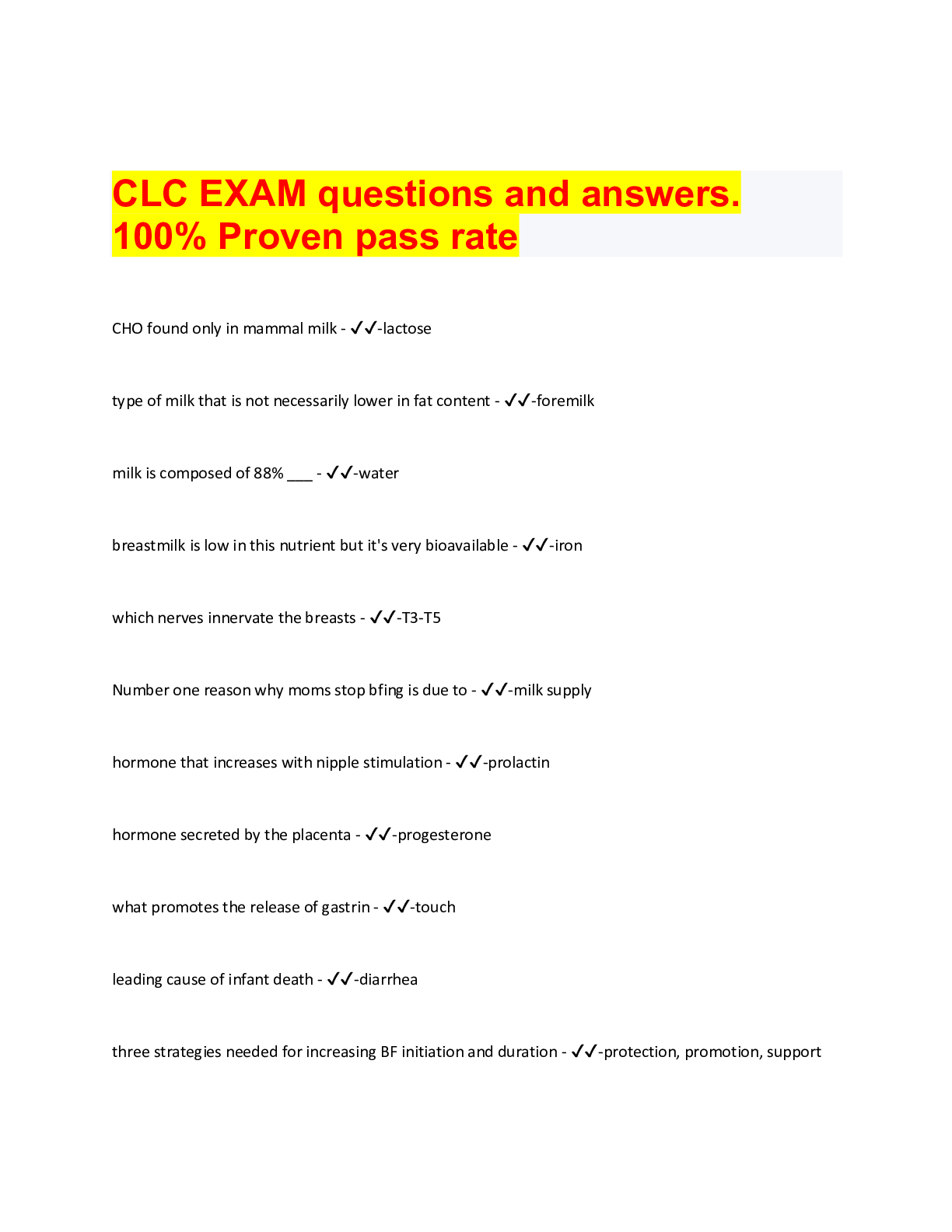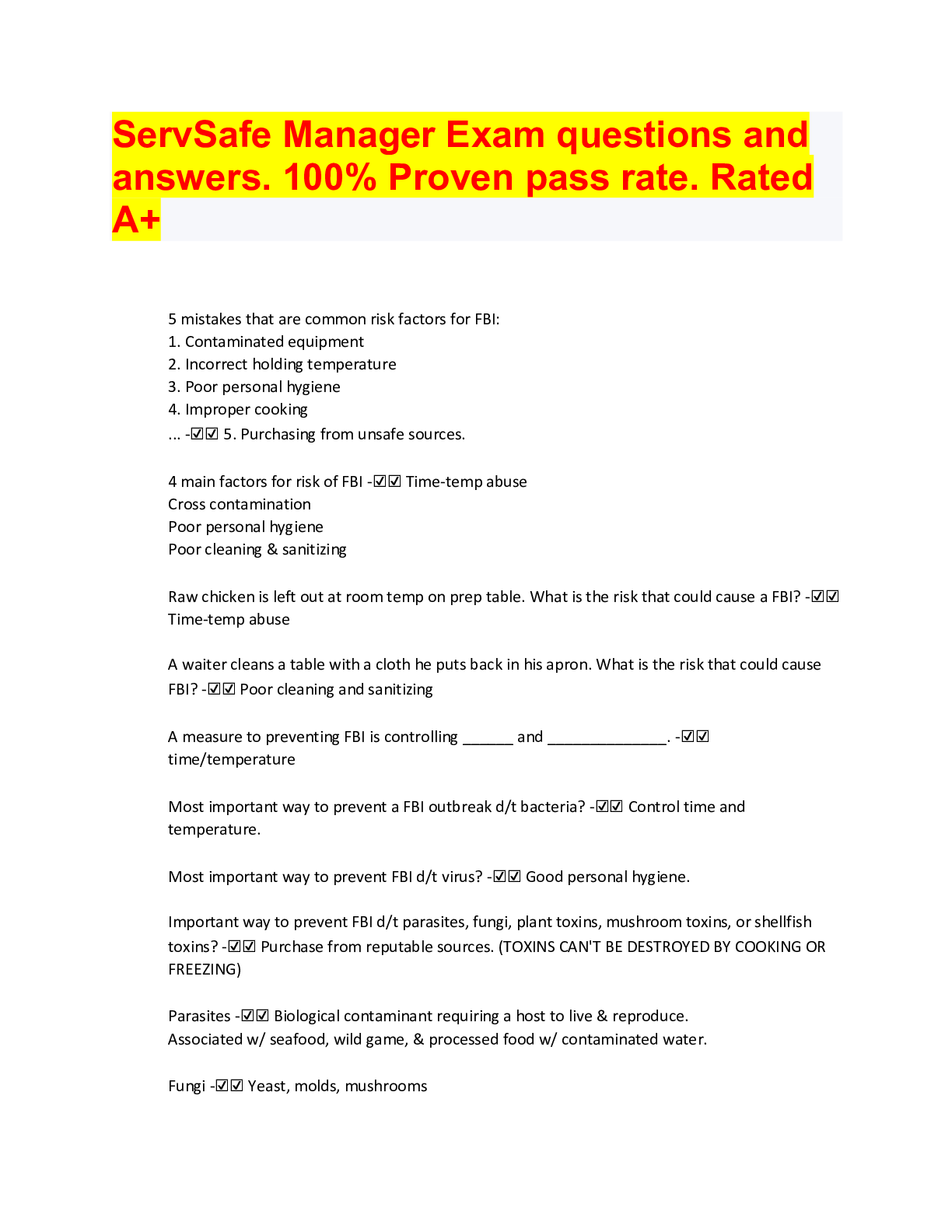*NURSING > QUESTIONS & ANSWERS > RBT / ABA Exam study guide sets with answers. 100% Proven pass rate. Rated A+ (All)
RBT / ABA Exam study guide sets with answers. 100% Proven pass rate. Rated A+
Document Content and Description Below
ABA reversal design - ✔✔A single case design on which baseline and intervention conditions are repeated with the same person. Alternating treatment design - ✔✔A single case design in which ... two or more interventions alternate systematically. Antecedents - ✔✔Environmental events that occurs before a behavior occurs. Applied behavior analysis - ✔✔The attempt to solve behavior problems by providing antecedents and/ or consequences that change a behavior. Aversion therapy - ✔✔A form of sensitization training in which a stimulus that arouses an inappropriate positive response is paired with an aversive stimuli. Backup reinforcer - ✔✔A reinforcer that may be received in exchange for a token. Backward chaining - ✔✔A chaining procedure that begins with the last element in the chain and progresses to the first element. Baseline - ✔✔A period during which the target behavior is recorded, but no attempt is made to modify it. Behavior - ✔✔Anything a person does that can be observed. Behavior analysis - ✔✔The science of behavior change, the study of functional relations between behavior and environmental events. Behavior chain - ✔✔A sequence of related behaviors, each of which provides the cue for the next, and the last of which produces a reinforcer. Behavior trapping - ✔✔The procedure of bringing a target behavior under the influence of its natural reinforcers by exposing it to those reinforcers. Behavioral contrast - ✔✔The tendency for changes in behavior outside the training environment. Behavioral repertoire - ✔✔All things an individual is capable of doing at any given moment. Bootleg reinforcement - ✔✔Reinforcement that is not part of; and tends to undermine, an intervention. Chaining - ✔✔The reinforcement of successive elements of a behavior chain. Conditioned reinforcers - ✔✔Reinforcers that are dependent on their association with other reinforcers. Conditioning - ✔✔Any procedure by which an event comes to elicit a response by being paired with an event that elicits that response. Consequences - ✔✔Environmental events that occur after a behavior. Contingency contract - ✔✔An agreement between two or more parties about what each is to do for the other. Continuous recording - ✔✔Recording each and every occurrence of behavior during a prescribed time. Contrived reinforcers - ✔✔Reinforcers that have been arranged by someone for the purpose of modifying behavior. Counterconditioning - ✔✔The use of Pavlovian conditioning to undo the adverse effects of earlier conditions. Covert behavior - ✔✔Behavior that can be observed only by the person performing it. Convert sensitization - ✔✔A variation of aversion therapy in which the paired events are imagined. Cumulative frequency graph - ✔✔A graph in which each data point indicates the total number of times the behavior has occurred up to that point. Daniel's dictum - ✔✔The principle that solving behavior problems with behavior analysis is more difficult than it appears. Daniel's is known for telling people "if you think the stuff your doing is easy our doing it wrong" Desensitization training - ✔✔Any form of counterconditioning that reduces an inappropriate negative response to an event. Differential reinforcement - ✔✔Any procedure that combines extinction and reinforcement to change the frequency of a target behavior. Discrimination training - ✔✔Any procedure that results in a target behavior having different frequencies in different situations. Discriminative stimuli - ✔✔Any event in the presence of which a target behavior is likely to have consequences that affect its frequency. DRA (differential reinforcement of alternative behavior) - ✔✔The procedure of reducing the frequency of a target behavior by reinforcing an alternative behavior. The idea is to give the person an alternative way of obtaining reinforcers. DRI ( differential reinforcement of incompatible behavior) - ✔✔The procedure of reducing the frequency of a target behavior by reinforcing a behavior that is incompatible with the target behavior. DRL (differential reinforcement of low rate) - ✔✔The procedure of reducing the frequency of a target behavior by reinforcing it only when it occurs at a low rate. Environmental event - ✔✔Any event in a persons environment that can be observed. Escape-avoidance learning - ✔✔A learning situation in which the target behavior results in escape form, or avoidance of, an aversive event. Extinction - ✔✔Withholding the reinforcers that maintain a target behavior. Extinction burst - ✔✔A sharp increase in the frequency of a behavior that is on extinction. Usually occur soon after behavior is placed on extinction. [Show More]
Last updated: 2 years ago
Preview 1 out of 13 pages

Buy this document to get the full access instantly
Instant Download Access after purchase
Buy NowInstant download
We Accept:

Also available in bundle (1)

The RBT BUNDLE
COMPRISE OF ALL QUESTIONS AND ANSWERS. ALL YOU NEED TO PASS. DOWNLOAD TO SCORE
By bundleHub Solution guider 2 years ago
$50
24
Reviews( 0 )
$10.00
Can't find what you want? Try our AI powered Search
Document information
Connected school, study & course
About the document
Uploaded On
Aug 14, 2022
Number of pages
13
Written in
Seller

Reviews Received
Additional information
This document has been written for:
Uploaded
Aug 14, 2022
Downloads
0
Views
374













.png)








